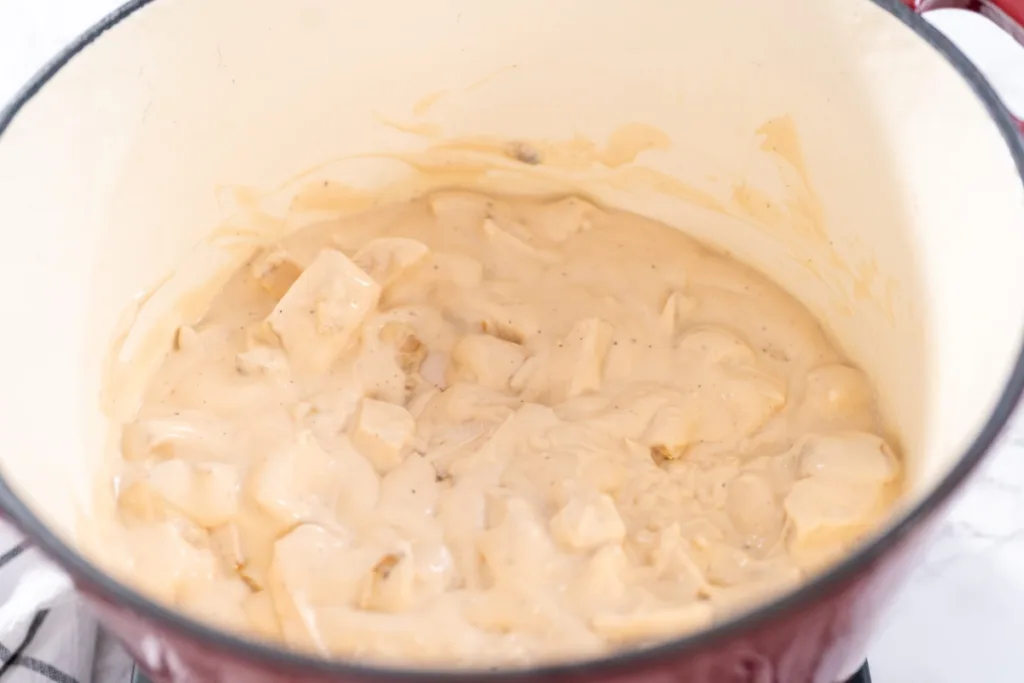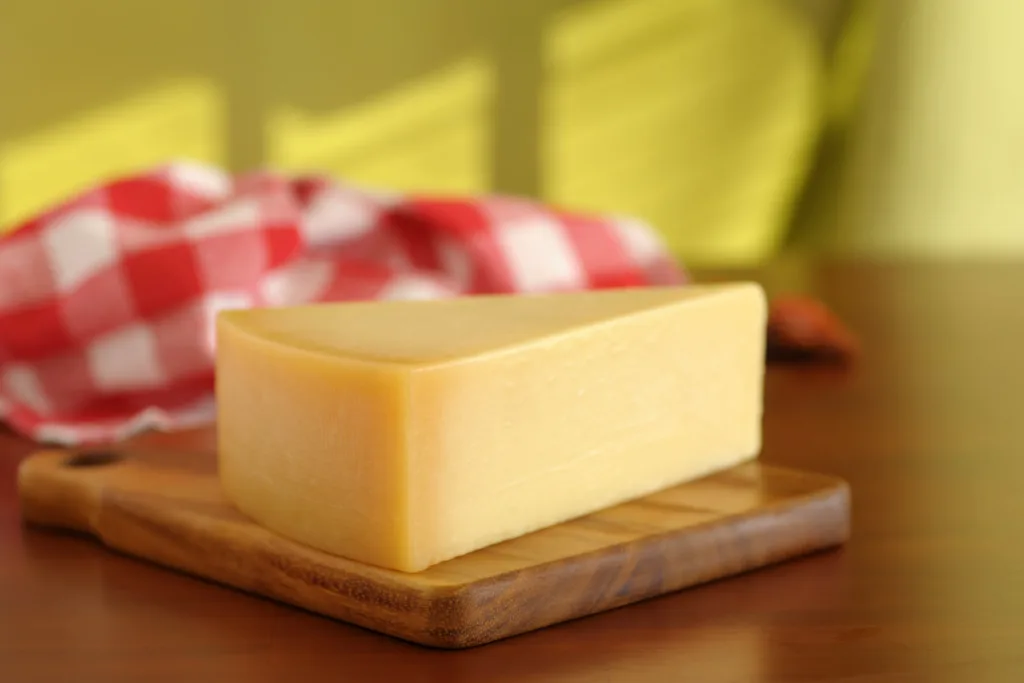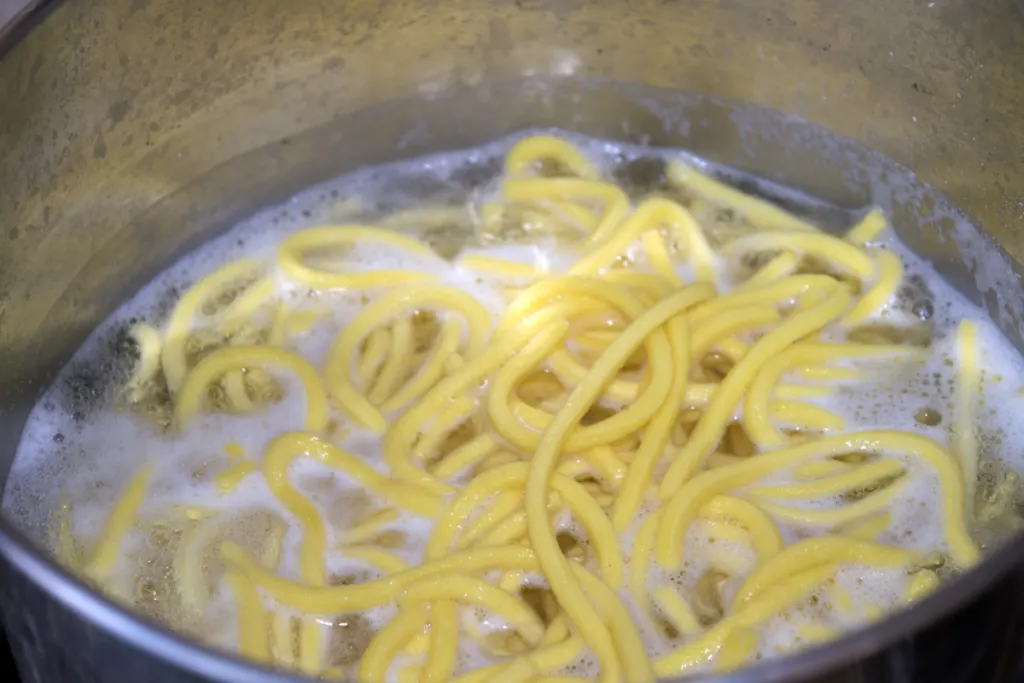A classic Italian sauce completely ruined. These are the last words or thoughts you’d wanna hear after making an alfredo sauce. A challenge many face is knowing how to thicken alfredo sauce. One popular method used to thicken alfredo sauce is to add a thickener like flour or cornstarch, cream cheese, or add an egg yolk. But, these aren’t the only methods you can use to thicken alfredo sauce. I’ve got a dozen more you need to check out!

Ways to Thicken Alfredo Sauce
The first 4 options are already present in the sauce, but there are certain methods and techniques you can employ to prevent or re-thicken your alfredo sauce back to its original texture.
Use Cream Cheese
Using a different creamer can greatly change the texture of your sauce, this one, being one of them. Cream cheese is a soft and spreadable cheese made from a blend of milk and cream, and is a particularly useful thickener for sauces, such as Alfredo sauce, due to its high-fat content. All you have to do is incorporate a few ounces of cream cheese into the sauce, stirring until it’s fully melted and blended. Add a splash more or stir for longer until you have that consistency you want.
Add Parmesan Cheese
Adding more parmesan cheese than what’s already present in the alfredo sauce is a great way to further enhance its flavor and thicken up the sauce. If you wanna use this method, you’d want to add the extra cheese gradually and whisk it thoroughly to ensure even distribution throughout the sauce. The amount of cheese you add should correspond to your liking, as the more cheese you add, the stronger the flavor will be.

Add Heavy Cream
Simply adding more heavy cream to the recipe can help to give it an even thicker texture. Heavy cream is a crucial ingredient in the sauce creation, as it contains a high amount of fat that emulsifies the sauce and gives it a smooth texture. Just start by heating it in a saucepan and then gradually add heavy cream while stirring constantly.
Keep adding cream until you achieve the desired consistency. If the sauce becomes too thin, simmer it on low heat. Once you have reached the perfect thickness, remove it from the heat and serve immediately.
Butter
You can even add a dash more butter to further improve the richness and creaminess of the sauce. Moreover, the fat in the extra butter can coat each strand of the sauced pasta, enabling the sauce to adhere more efficiently.
Just add the extra amount of butter in a saucepan over low heat. Gradually whisk the sauce into the melted butter while stirring constantly until it’s fully incorporated. Then, continue to cook the sauce over low heat, stirring frequently, until you have a thickness you’re happy with.

Shredded Cheese
Another type of cheese you can add is shredded cheese. This cheese not only enhances the taste of the sauce but also helps to create a smooth and creamy texture as the cheese melts into the sauce, helping to thicken it.
Begin by making the sauce as you usually would with butter and heavy cream. Once the sauce is heated through, slowly add the shredded cheese while stirring constantly until it fully melts and blends with the sauce. You should always add the cheese gradually to prevent clumping and ensure a smooth texture.
Using Cornstarch
Cornstarch is a universal thickening agent preferred by many cooks for its gluten-freeness and neutral flavor. Using it is as simple as taking a separate bowl and mixing one tablespoon of cornstarch with one tablespoon of cold water. Stir the mixture until the cornstarch is entirely dissolved.
After that, slowly pour the cornstarch mixture into the simmering alfredo sauce, stirring constantly with a whisk or spoon. Continue to stir the sauce for roughly two minutes or until it thickens to the consistency you want.

Flour
Flour is a very common thickening agent in sauces. It also contains gluten, which gives it a unique texture and flavor when used as a thickening agent. This can be applied to alfredo sauce by itself or by making a roux. A roux is a mixture of flour and fat that’s used as a base for many sauces and gravies.
In a separate pan, melt butter over medium heat and add flour to the pan, stirring constantly until the mixture forms a smooth paste. Cook the roux for a minute or two to remove the raw flour taste. Next, slowly pour the roux into the simmering Alfredo sauce while whisking continuously to prevent lumps from forming. Keep stirring the sauce for a few minutes until it thickens to how you like it.
Egg Yolks
Egg yolks are another typical thickening agent used in Alfredo sauce. This is because egg yolks contain lecithin, a natural emulsifier that helps to bind liquids together and create a smooth, creamy texture. When you add them to the sauce, they help to thicken and stabilize the sauce, preventing it from separating or curdling.
To use them, begin by whisking the yolks in a small bowl until they are well-beaten. Gradually add a ladleful of the hot Alfredo sauce to the egg yolks while whisking continuously to prevent them from scrambling. Then, add the egg yolk mixture back into the saucepan gradually while whisking constantly until the sauce has thickened to your liking.

Roux
Roux, a classic French technique, involves cooking equal parts flour and fat into a paste-like mixture to thicken sauces and soups. To thicken Alfredo sauce with a roux, melt butter in a saucepan, add flour, and whisk into a smooth paste over medium heat. Cook the roux until it achieves a light golden brown color.
Next, pour hot milk into the roux while whisking to prevent lumps, continuing until the mixture thickens. Once thickened, incorporate Parmesan cheese into the sauce, stirring until melted and well-blended. This method enhances Alfredo sauce with a rich and smooth consistency.
Toss in Some Pasta Cooking Water
You’ve probably got this one lying around, so why not try using it in your sauce. It’s a very useful method to add a small amount of starchy and salty water to the sauce while it cooks. The starch in the water acts as a natural thickener. This results in a rich, creamy texture without the need for extra cream or butter.
Just heat Alfredo sauce in a skillet over medium heat. As it simmers, gradually incorporate small amounts of the reserved pasta water while stirring constantly. Be cautious not to add too much water at once to avoid thinning the sauce. Instead, continue simmering and adding small increments of pasta cooking water until achieving the desired consistency.

Tapioca Powder
This powder creates a smooth and glossy texture similar to traditional alfredo sauce. It’s also a neutral-tasting thickener that won’t alter the flavor of your sauce. Just gradually add small amounts of tapioca powder while whisking constantly to avoid clumps.
As you add the powder, the sauce will begin to thicken. Continue whisking until it reaches your desired consistency. If the sauce is still too thin, add more tapioca powder as needed. Adding the powder slowly is also the key to preventing the sauce from becoming too thick.
Add Pureed Cauliflower
Now, this isn’t your typical thickening agent, but it can certainly be used if need be. Cauliflower is a nutrient-rich vegetable that’s low in carbs and calories but high in fiber. Start by steaming or boiling a head of cauliflower until soft and tender. Transfer the cooked cauliflower to a blender or food processor and blend until smooth and creamy.
After preparing your Alfredo sauce, heat and simmer it as usual, gradually incorporating small amounts of the pureed cauliflower while whisking continuously. Add the puree slowly to prevent the sauce from becoming overly thick. Whisk consistently until you achieve your desired thickness, and if the sauce remains too thin, add more pureed cauliflower as necessary.
FAQs
What is the best way to thicken alfredo sauce?
The best way to thicken alfredo sauce is to use flour or cornstarch. These are popular thickeners typically employed to absorb water in the sauce and create a thicker substance. Though flour does contain gluten, so be careful if you have gluten allergies.
How do you keep Alfredo sauce from getting thick?
To prevent Alfredo sauce from becoming excessively thick, use caution with the quantity of thickening agents, such as flour or cornstarch. Initially, incorporate a small amount and gradually adjust if needed to avoid over-thickening. Maintain a watchful eye on the heat level during the simmering process, opting for a lower setting to slow down thickening and adjusting the cooking time as required.
Will Alfredo sauce thicken as it cools?
Yes, Alfredo sauce tends to thicken as it cools. The primary reason for this is that the fats in the sauce, such as butter and cheese, solidify at lower temperatures. As the sauce cools, these fats become more solid, contributing to a thicker consistency.
